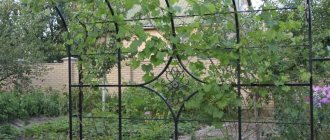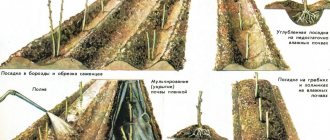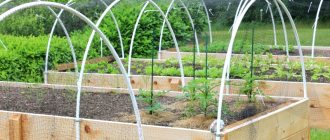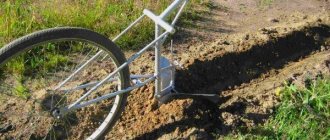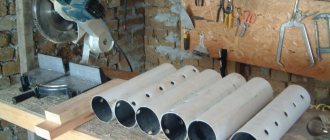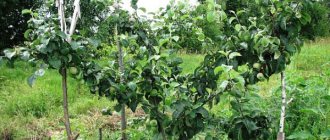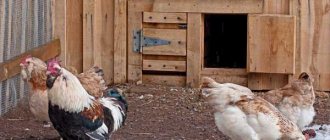Raspberries are a favorite treat for many. It is considered one of the most popular berries in our country. It grows well, does not require much care, the harvest is regular and rich, and already in the second season gardeners can enjoy tasty and aromatic fruits.
And if you put effort into growing, the harvest will be larger, tastier, and even earlier. The use of special supports - trellises - will help in caring for your garden pet. And, of course, this article. Let's understand how to care for raspberries.
We also advise you to look at the article about raspberry diseases.
Why do you need a trellis for raspberries?
The correct trellis for raspberries helps prevent damage to branches that bend down under the load of fruit. In addition, most varieties reach a height of two meters, and due to the thinness of the stems, there is also a high probability of them bending. On such branches, ripened berries come into contact with the ground, and parasitic individuals appear on them, which eat and destroy them.
If low-growing raspberries are planted on a personal plot, then there is no need to arrange trellises. If these are bushes of early ripening and highly productive, then you cannot do without a garter.
Advice! The installation of a trellis for raspberries planted in rows is mandatory. If the bushes are planted in a chaotic manner, separately from each other, then it is worth using additional supports installed next to them.
Classification of supports
Growing raspberries using trellises is the most convenient option for raspberry lovers who want to increase their yield.
The good thing is that these supports can be created from materials that are easy to find in your garden:
- wood;
- steel or plastic pipes;
- pillars and stakes.
If wood is used as a base, before installing the structure, the material must be treated with a vitriol solution for two to three days. To prepare it, you need to add a kilogram of chemical to 50 liters of water.
You can categorize supports for climbing vegetation as follows:
Single-cavity. These are posts with wire or twine stretched between them. It is this element that is designed to provide support to the branches. Each branch of the bush must be secured separately. This option is perfect for a small raspberry garden with 3-5 bushes.
Single-cavity options are divided, in turn, into:
- fan (bush);
- vertical;
- horizontal;
- inclined;
- free.
Double-lined. The wire or twine is stretched in two parallel rows at a distance of half a meter. Such planting allows you to form the correct crown and not thicken the plantings. After all, raspberry branches usually lean in different directions. Can be used on both large and small areas.
They differ in the following designs:
- letter T - a vertical column with horizontal dies. Twine is attached to them and branches are tied;
- letter V - raspberry shoots are located at a slight angle, support is provided on both sides. At the same time, the central part of the trellis is free and well ventilated;
- letter Y - a trellis of this shape is movable and allows you to control the angle of inclination.
The dimensions and designs of the listed structures will help you choose a suitable support for your dacha. The bush support is most often used, due to the fact that it is easier to tie up branches on it. However, professional studies have shown that this variation provides worse yields than with other types of structures. For example, with an improved one-sided support, the raspberry crop can be harvested a couple of times more than using a vertical trellis. This becomes possible by reducing losses during ripening.
Benefits of growing raspberries on a trellis
Among the positive aspects of gartering raspberries on a trellis, experienced gardeners note:
- uniform illumination of berries by sunlight;
- low degree of susceptibility to fungal diseases;
- increased yields;
- protection of the future crop from contact with the ground;
- convenience when carrying out sanitary treatment of bushes;
- simplified planting care;
- the stems do not bend or break;
- improving air circulation between plants;
- well-groomed raspberry bushes;
- guaranteed dryness between plants;
- freedom to move between rows.
To obtain healthy and abundantly fruiting plantations, you need to know how to properly tie raspberries to a trellis when supports are needed. Do-it-
yourself raspberry trellises in the country are convenient and functional structures that can be used for more than one season, but for several decades. especially if they are made of metal.
How to care for plants?
In principle, care is standard and quite simple. The plants are periodically watered and the soil is loosened. Weeding is done from time to time to prevent weeds from growing a meter tall. With proper mulching, caring for raspberry bushes is incredibly easy.
In early spring, caring for raspberries comes down to applying fertilizer. Experts on our site recommend doing this in March, when the snow has not yet completely melted. Do you know why? Melt water will improve the penetration of nutrients into the soil.
Are the berries starting to appear on the plants? It's time to do the second feeding. It is better to do without nitrogen, limiting yourself to only a phosphorus-potassium mixture. Maintain proportions - excess fertilizer is unlikely to lead to good yields. But the number of leaves and volume will increase sharply.
Types of trellises for raspberries
Trellis for remontant raspberries and other varieties that require garter have several design variations. These support structures provide for the installation of supports at equal distances from each other. If the rows are quite large and long, then it is more advisable to use 3-4 rows of wire to arrange them. If the plantations are small, then a reinforced cord or thin wooden stakes are quite suitable. There are one- and two-strip trellises.
Single strip trellis
This version of a raspberry trellis involves the presence of several rows of wire between securely dug supports. Each stem is tied to twine. They can be placed either vertically or in a fan-shaped manner.
A single-strip trellis for growing raspberries is easy to manufacture, but requires gartering each shoot
The optimal height of a single-strip trellis for raspberries is 2.5-2.7 m. It is deepened into the ground by 80-90 cm. An interval of 3-4.5 m must be maintained between the posts. The wire is fixed in one plane, where the first row is located on height from the ground is 70 cm, the second is 1 m, and the third is 1.5 m. Among the disadvantages of this design is the need to tie up each shoot, which is not very convenient and easy on large plantations; this can only be done in small areas.
Trellis in the shape of the letter T
T-shaped structures for raspberry bushes can be made from wood, reinforcing bars, metal corners, and pipes. The crossbars must be fixed to the posts at right angles, and the wire must be pulled along the edges. The stems are directed on different sides, fixed in longitudinal rows. Thanks to this arrangement, the young shoots are fully provided with both sun and warmth.
The T-shaped trellis is easy to manufacture, the plants do not shade each other, and sunlight is evenly distributed between them
V-shaped trellis structure for raspberries
The supporting structure has two load-bearing planes that deviate from the middle of the row in different directions. This design is also called two-lane inclined. The process of forming raspberry bushes follows the same pattern as in the previous case. The recommended distance between the top rows and planes is up to 2 m.
It is not necessary to tie the shoots in a V-shaped trellis; they can be placed directly on the wire
Y-shaped design
This is one of the best trellises for raspberries, since there are moving parts - blades mounted on hinges. Thanks to this, if necessary, it is possible to adjust the angle of inclination; the blades can either be lowered or raised.
The Y-shape design allows the planes to be adjusted if they are hinged
Horizontal tent
Due to its bulkiness, this version of the support structure for tying raspberry bushes is mainly used on large farms, where harvesting and caring for plants is carried out using agricultural machinery. In summer cottages, the tent trellis did not take root due to difficulties in mulching the soil, pruning bushes, and applying fertilizer compounds.
It is advantageous to use a tent structure when growing raspberries over large areas; for summer cottages this option is not relevant due to the difficulties in caring for plantings
Trellis design options
A trellis is a certain number of pillars arranged linearly in a row, covered with several layers of wire. Trellis are divided into two types:
Despite the lower efficiency of single-plane trellises, knowledgeable summer residents find use for them in planting areas with a limited area.
Single strip trellises
Types of single-strip trellises, whose function is to hold raspberry bushes between supports in the form of pillars covered with twine:
- fan;
- vertical flat;
- free;
- inclined;
- horizontal.
The design of a structure made of supports covered with wire or twine is the same for all species, as is the role of fastening bush plantings at the vegetative stage of development. The exception is the horizontal type of trellis, working with which requires compliance with some nuances. The above varieties differ in the methods of gartering raspberry bushes.
A horizontal trellis is used to prepare raspberry plantations for the winter season. Having installed a horizontal trellis, at the beginning of the spring season, last year's shoots are bent to the ground surface and fixed in a horizontal position. This method of forming bush plantings is aimed at facilitating the procedure of covering raspberry beds for the winter.
Note. When using the method of horizontal tying of raspberries, branches with fruits grow in a vertical direction along the entire length of the shoot, and the buds located in the base area do not come out of hibernation.
If you have a small number of raspberry beds, you can use any of the presented types of single-strip trellises. The negative point is that all stems require separate fastening. For use on large raspberry plantations, this method is considered too time-consuming.
Two-strip trellises
Two-strip trellises are considered improved and are used on a large scale. List of existing two-lane trellis schemes:
- T-shaped;
- V-shaped;
- Y-shaped;
- tent horizontal.
In addition to fixing ripening berry plantings, a two-strip trellis helps to properly organize the placement of raspberry plantings. This is a wire stretched in two rows, keeping them parallel. The approximate size of the distance between the wires is 1 meter.
T-shaped trellis
You can make a T-shaped trellis structure, creating a kind of box for raspberries, from reinforcement fragments, beams or metal pipes fixed perpendicularly. The wire tension points are the extreme area of the predominant horizontal part of the trellis structure. When forming bushes in a raspberry bed, fruiting shoots should be placed in the opposite direction, freeing up the central area for young shoots.
Having the same name as a two-lane inclined plane, this type of design consists of placing two inclined planes. The method of forming beds is carried out according to a similar scheme for a T-shaped trellis.
V-shaped trellis
The placement of the fence in the form of V-shaped trellises is organized in the center of the row. The tilt is set to 20 degrees. Each side is covered with two rows of wire.
Y-shaped trellis
The modernized design - a support for raspberries, includes the presence of such parts as movable blades, secured in a hinged manner. The Y-shaped design allows you to adjust the pitch angle with the blade elements raised or lowered.
Y-shaped trellis diagram
Tent horizontal trellis
This trellis is installed with the expectation of machine harvesting. Gardeners do not use this design due to difficult access to row spacing, problems with holding branches with raspberry berries, and complications in the process of mulching, pruning and fertilizing.
Example of a trellis with a canopy
How to make a trellis for raspberries with your own hands
To assemble a supporting structure in a garden plot for gartering raspberries, gardeners use not only wooden blocks, but also metal/plastic pipes. In order for the material used to serve for a long time and reliably, this applies to wood and metal, it must be pre-treated with a protective compound.
Trellis for raspberries made of plastic pipes
Step-by-step instructions for making a raspberry trellis with your own hands:
- Dig holes in the area reserved for planting bushes with a depth of 80-100 cm. They should be located in the center of the row. Their diameter will depend on the cross-section of the plastic pipes used.
- Insert the pipes into the prepared holes.
- Screw cross beams, their length 40-50 cm, to the pillars, whose height is 1.8-2 m.
When the crop is harvested, the trellis can also be removed. The plantings are mowed at this stage. If the raspberries are small in size, then you can cut them out by hand.
Raspberry support made of metal
Having decided on the area where they plan to plant berry bushes, they begin installation work. Metal pipes must first be treated with an anti-corrosion and primer compound to extend their service life.
The process of making trellises from metal pipes is as follows:
- Dig a hole of suitable diameter.
- They make a T-shaped structure by connecting pipes using welding equipment. After this, the pillars are installed, controlling the slope with a building level.
- Stretch wire or reinforced twine.
In the first years of planting berry bushes, the bottom row should not be very high from ground level so that it is possible to tie the raspberries to the trellis. This distance can be adjusted in the future.
Making a trellis for raspberries from a mesh
Mesh is a universal building material that gardening and vegetable gardening enthusiasts use to successfully grow agricultural plants. There are several options for using it:
- The galvanized mesh is stretched vertically onto pre-installed poles. Thanks to this, plants can be tied at absolutely any height.
- Another way to use metal mesh is made from PVC material with large cells. Set it up in a horizontal position. The height from the ground surface should be up to 1 m. It can also be mounted on previously dug pillars. As they develop, the raspberry shoots will grow through these cells and not bend in different directions. This is simple and does not require any labor from the gardener in the future; no garter is needed here.
Height and other dimensions
How tall should a raspberry trellis be? The optimal support height is 1.8–2.5 m. It is suitable for structures of any type. When choosing supports, you need to ensure that they are stable.
The distance between load-bearing elements usually ranges from 75 cm to three meters. It is chosen depending on:
- reliability, height and thickness of the selected material for supports;
- row length;
- method of tying bushes;
- elasticity of tensioned wires.
Raspberries are tied in two places at different heights. There are several options. The scheme is chosen based on the characteristics of the raspberry variety. Most often this is done like this: the first row is tied at a height of about a meter, the second - 1.5–1.70 cm (for tall varieties). Or use the following scheme: the first row is at a height of 50 cm, the second is 1.2–1.5 m (for medium-sized varieties).
Installing a trellis for raspberries
It is better to choose metal or wooden supports, corners, and reinforcing rods as the main pillars for the trellis structure. Considering the load that berry bushes will exert as they grow and develop, it must be a reliable material with good strength characteristics. If you want to make an adjustable version of the trellis, you will need hinged parts.
When using wooden blocks, they must first be prepared, treated with resin or another composition that protects the material from the negative effects of moisture. The wooden components of the supporting structure must be kept in a solution of copper sulfate for 20 hours. To treat metal surfaces it is worth using bitumen varnish.
First you need to mark the area where you plan to install trellises. If shrubs have been growing on it for a long time, then the pillars must be placed along them, carefully so as not to damage the root system. In the case of developing a new territory in the garden, the first thing to do is determine the place of support, and then the raspberry seedlings.
The optimal distance between adjacent pillars varies in the range of 2-3 m. They are buried using a shovel. The poles must be stable on the ground and not wobble in different directions. It is best if they are concreted.
To create trellises for berry bushes, use either soft metal wire or reinforced twine, which, although not long lasting, causes less injury to the shoots. Plastic wire with a diameter of 3 mm has proven itself well. You can buy it at any hardware store. But tying raspberry bushes using steel or copper wire without an insulating layer is not recommended, otherwise the stems will often be damaged. Nylon fishing line is also not suitable for these purposes, as it is not capable of holding the shoots in a given position; they will only clump together.
What material is needed?
To construct a trellis, you will need to use wooden blocks or pipe scraps 220-250 cm long with a diameter of 80-100 mm. Reinforced concrete structures (section 100 x 100 mm) are also used as supports.
Also needed:
- bitumen for coating the bottom of the pillars;
- anchors for supports;
- stainless steel wire or polypropylene twine for tension between posts;
- soft wire or natural twine for tying up shoots.
If wooden supports are used, they should be treated with an antiseptic, for example, copper sulfate.
Can it be made from polypropylene pipes?
There is no better way to increase your raspberry yield and make it easier to care for than by tying the branches to a trellis. Although the process is labor-intensive, it completely pays for itself. You can make trellises yourself or buy ready-made structures made of metal or propylene. In the latter case, the fragility of the material should be taken into account. Therefore, it is better to use it on young plantings or reduce the distance between supports.
How to grow raspberries on a trellis
After preparing the area and installing trellises, they begin to plant raspberries in a permanent place. Organics are consumed taking into account 4 buckets per 1 sq. m, they add it before digging the area. It is advisable to plant berry crops in the spring.
It is best to plant in April, when the threat of return frosts has passed.
When a young bush is placed in the center of a planting hole, into which 0.5 liters of wood ash is added, the spreading of its roots along the sides should be controlled. Finally, the seedling is sprinkled with a layer of fertile soil, watered (10 liters per plant) and mulched with freshly cut grass and straw. Further care of the crop consists of treatment against harmful insects, diseases, pruning, watering and destruction of weeds.
How to fence beautifully?
A fence, a specially installed fence that protects the bush from the wind, and the wall of a house or outbuilding can serve as a support for raspberries. But it is much more convenient to install special trellises that will make caring for raspberries and harvesting easier.
You can create a real work of art from shrubs: a hedge will divide the area into zones or decorate recreation areas.
- A tunnel of tall varieties is formed by tilting and tying the tops of branches mounted on wire.
- A flowerbed is created from two bushes, the young shoots of which are entwined with a hoop installed as a support.
- A border of low-growing raspberry varieties looks very impressive; it is planted in specially prepared beds along paths and lawns.
- The fence is planted in a checkerboard pattern, intertwining the stems with each other.
These and many other options are used, trying to make the area around the house more decorative. Some types of raspberries form in the form of a tree, leaving 2-3 strong shoots and trimming the trunk.
It is possible to use trellises and coarse mesh chain-link or plastic fencing as support. You can create green terraces and tunnels, which are especially popular with children and help train them to help with dacha chores.
How to tie raspberries to a trellis
Gardeners use different options for tying to the supporting structure. Each of them has its own characteristics, pros and cons.
Double garter
This method involves installing two-meter slats at a distance of four meters from each other. A wire is pulled between them in parallel, where the lower one should be 1 m from the ground surface, and the upper one – 1.5 m. The shoots are fixed at two points and spread on different sides, fixed at a distance of 50 cm from each other.
Double garter makes it possible to fix each shoot
Among the advantages of this method, an increase in crop yields is noted, since it is possible to tie up each shoot. One of the disadvantages is the difficulty in picking berries.
Scandinavian way
In general, there are no special differences from the previous garter method. There are only different heights at which the plastic wire is placed. The bottom row is arranged 1 m from the ground, and the second - 2 m. The shoots are not tied to the wire, but wrapped around them to form the letter V.
The Scandinavian method of gartering a bush reduces the risk of developing diseases due to good ventilation of plantings
Among the positive aspects: sufficient air circulation between plants, berries in the access area, there are no difficulties with harvesting them. In addition, new growth easily breaks through and grows.
Single method
A T-shaped structure is installed on a site consisting of two supports with a height of 2 m, where the distance between them is 3-4 m. The pillars are buried half a meter into the ground. After this, the wire is pulled in several rows and each shoot of the bush is tied up separately. It is optimal that its top is not more than 20 cm above the wire, otherwise it will bend.
The single garter method eliminates damage to the bush in strong wind conditions
One of the advantages of such a raspberry garter is the good resistance of the shoots to gusts of wind. Among the disadvantages is a high probability of damage to young branches.
Mobile turnstile
This method has the ability to adjust the position of the planes at different stages of the growing season of the berry bush. The shoots are fixed on supports, and if necessary, the angle of inclination of the trellis is changed. This greatly simplifies the process of collecting fruits, but requires adherence to manufacturing technology.
Growing raspberries on a movable trellis has many advantages: regulation of planes during different periods of the growing season, simplified care and harvesting process
fan garter
Two-meter posts are installed between the bushes, then the plant is divided into 2 parts and each is tied to a separate rail. In the end, it turns out that one part of the bush will be located on one rail, the one on the right, and the other on the one on the left.
The fan shape of the bush gives more light and warmth to each shoot
A video on how to make trellises for raspberries with your own hands will help you carry out the work simply and without problems.
Raspberries: planting and caring for bushes of a fruitful plant
Raspberries are an unpretentious crop whose fruits have a pleasant taste and antipyretic properties. The jam made from this berry is very tasty and aromatic. Dense raspberries look beautiful in any area. Raspberries can be planted in spring or autumn. Growing raspberries in the country is not as complicated as it seems. If everything is done correctly, the bushes will quickly take root, begin to grow intensively and produce a rich harvest. From this publication you will learn how to tie raspberries to a trellis.
It is necessary to carefully choose a place for planting raspberry bushes
Raspberries belong to the Rose family. It is usually an upright shrub with small thorns. The flower of the plant is small. The fruits come in different shades - from light pink to almost black (in the case of blackberry raspberry varieties). Raspberries are yellow in color.
The branches on which the fruits will grow appear in the second year of the plant’s life. In the southern regions of Russia, fruits can appear already in the first year of planting raspberries. Currently, breeders have developed remontant raspberry varieties that are capable of producing crops at lower ambient temperatures.
Features, methods and schemes for planting raspberries, fertilizer for the plant
Raspberries should be planted on neutral or slightly acidic soils. It is better to choose a place for the bush that is sunny, protected from strong winds, and has good snow cover in the winter. You also need to ensure that the predecessors of raspberries are not plants that are prone to the same diseases, for example, tomatoes, strawberries, potatoes.
Raspberries can be planted in spring and autumn, the soil should be neutral or slightly acidic
The optimal time for planting raspberries is spring and autumn; green cuttings are planted in summer. It is necessary to prepare the soil for planting in advance, in the case of autumn planting - a month in advance. In spring, this can be done immediately 2-3 weeks before placing the plant in the ground.
Before planting, the future raspberry tree must be fenced with slate, digging it to a depth of about 35-40 cm. This must be done so that the raspberry root system does not spread to other beds and areas. The distance from the raspberry bush to the fence must be at least 1 m. There are several ways to grow the plant:
- in separate bushes - about 10 branches are left on the bush and planted in separate holes;
- trellis or tape method - plants are planted in one row in trenches.
To plant individual bushes, you need to make holes approximately 40 x 50 cm in size. You need to pour a small mound of the planting mixture into each hole. Before planting, it is recommended to moisten the roots of the plant in a nutrient solution of mullein or a special solution of planting mixture. Then they lower the raspberries into the hole and sprinkle the roots of the plant with a fertile layer of soil.
Raspberries can be grown as individual bushes or tied to a trellis
It is necessary that the distance between the bushes be about 1 m, and between the rows - about 2 m. The neck of the root should protrude several centimeters above the soil, so that after complete shrinkage of the soil and watering it will be at ground level. The roots of the plant should not be lowered too deeply, as this can lead to rotting of the root bud. A high planting is also undesirable for raspberries.
In the case of trench planting of bushes, it is necessary to dig a trench about 45 cm deep and about 50 cm wide. The number of trenches depends on the number of intended rows of raspberries. The optimal distance between rows is about 1 m, the gap between plants is approximately 40 cm.
You need to fill the trench with a nutritious planting mixture. It includes:
- rotted manure or compost;
- fertile topsoil;
- mineral fertilizers - double superphosphate is best.
When planting in dug trenches, it is necessary to add a nutritious planting mixture
All components are added to the trench in layers or a mixture is made by mixing the components.
After planting, the seedlings must be watered and then mulched with humus, peat or regular dry soil. If the soil is well moistened by precipitation, then additional watering is not required. Provided that the buds of the plant are well developed, they need to be trimmed, leaving 30 cm.
Helpful advice! Nitrogen-containing fertilizers are not recommended to be added during planting. Raspberries will not take root well. It's better to add a little ash.
How to properly tie up raspberries: tips on care, watering and pruning
Raspberries need to be watered well, but in moderation so as not to flood the roots. The plant especially needs sufficient saturation with liquid in the spring and summer.
Raspberry stems must be shortened annually after harvesting the berries or in the spring.
Pruning for raspberries is needed to shorten fruiting shoots and remove too thick and unnecessary shoots at the roots. Usually, in the spring after planting, fruit-bearing branches are pruned by about 20 cm. From the second year of life, the stems of the plant are shortened annually after harvest or in the spring. After the winter period, the branches are cut off by about 10 cm to a strong bud.
In order not to frequently dig up the soil, the row spacing can be mulched - covered with straw or peat. To prevent frost damage to raspberries, many varieties need to be bent down. To do this, you need to tilt the bushes towards each other and tie them.
To prevent the bushes from breaking under the weight of the fruit, they need to be tied up. The most commonly used method is the fan method. In this case, you will need to drive two sticks between the bushes - and raspberries are tied to them at different heights: part of the shoots of one bush and part of the stems of the neighboring one. The result will be a kind of fan.
To prevent raspberry bushes from breaking, it is recommended to tie them up
In the case of the trench planting method, the best option would be to use a trellis garter. You will learn more about how to make a trellis for raspberries later in this article.
When to install a trellis
How to make a support for raspberry bushes has already been discussed. But there is another important question: when exactly will be the best time to install this structure.
The installation of the support should be planned exactly for the period when it is planned to plant the raspberry bushes. And when the young shoots begin to bear the first berries, they must be tied up to protect them from being broken.
We must not forget about pre-treatment of both wood and metal - iron sulfate or other solution with similar properties.
Weeds and more - what to do
The close proximity of raspberry roots makes the bush very sensitive to various weeds - raspberries have to share their living space and feeding area with aggressive weeds.
Of the ubiquitous varieties, wheatgrass is the most dangerous; it literally takes away nutrition from raspberries. You should get rid of wheatgrass before planting raspberries. Otherwise, you will have to exterminate the weed with pinpoint precision using Roundup.
“And not only” in the subtitle is said for a reason - raspberries react to their own root shoots... like an aggressive weed. This “nettle” (the so-called raspberry shoots) must be removed before they draw out all the juices from the bush.
You cannot pull it out - just cut the roots with a shovel at a depth of about 5-10 cm. This is quite enough for the shoots to gradually dry out.
